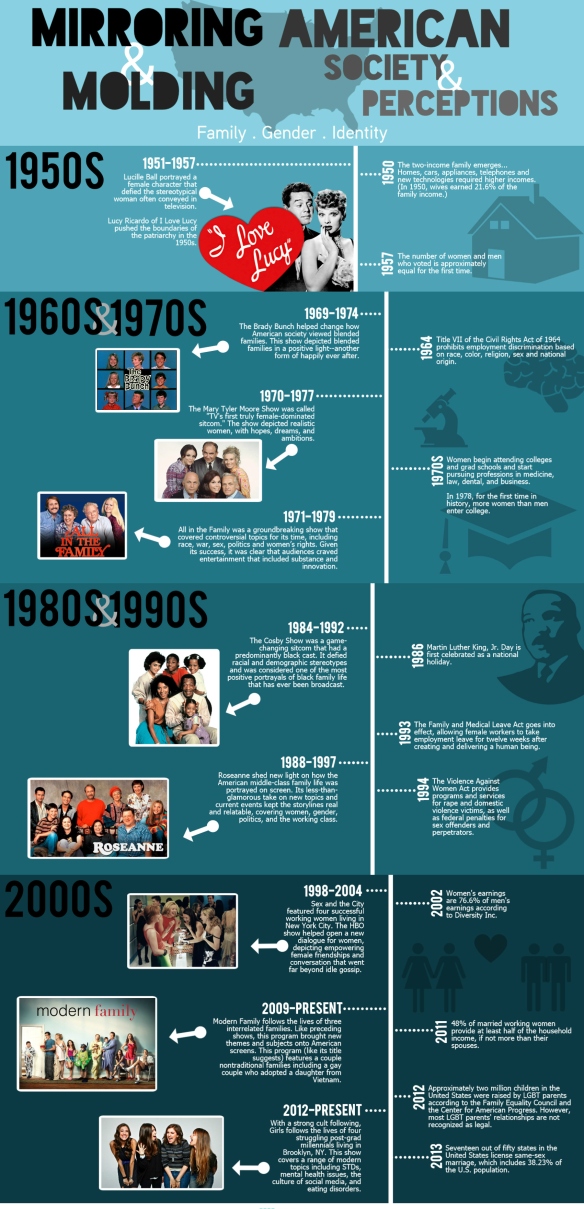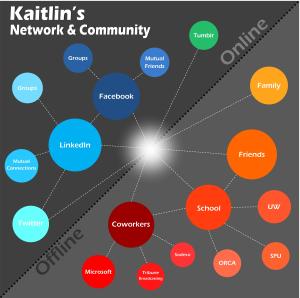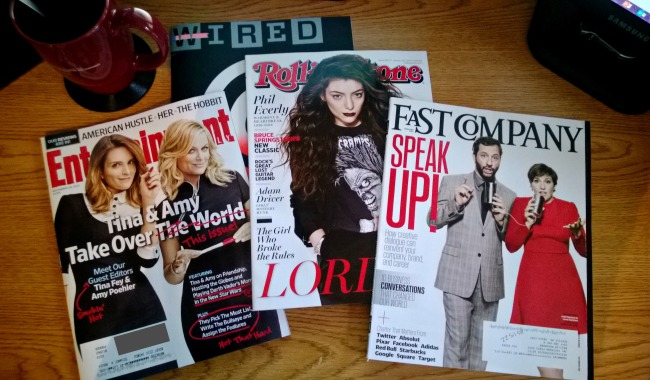I was raised by a strong, feminist mother who grew up in a small town in Iowa. Not destined to be a farmer’s wife, she earned her undergraduate and graduate degree (the first of her family) and moved to a city nearly 1,400 miles away. She was a trailblazer—leaving a cloud of dust behind her. I’m very aware of the fact that the road traveled by my mother wouldn’t have been possible without the blood, sweat, and tears of the strong women who came before her. When raising my sister and I, both she and my father educated us to strive for independence and equality.
Having grown up in America watching American television, different shows have shaped my perceptions. From learning rhymes and stories on Sesame Street to understanding satire on Saturday Night Live, television, often a centerpiece of an American living room, has served as a thermometer to society—gauging the societal temperature and changing times.
The idea that as people talk they’re producing and reproducing culture is derived from the socio-cultural tradition of communication theory (Giffin, 2012, p. 43). Television is a medium where people share their stories and ideas—people create culture. American television programs are both influential and serve as a mirror to society. Having said that, I set out to create a visual representation that would serve as a snapshot of how America’s culture regarding family, gender roles, and identity has evolved from the 1950s to today. Specifically, I wanted to display America’s most popular television shows in each decade and how they corresponded (or not) to what was happening during the time they were airing.
When I set out to create this visual, I wanted to try a medium that I hadn’t used before: infographics. I also wanted to use an application or software piece that I wasn’t familiar with. I ended up using Piktochart, an infographic design application. There were many pre-formatted options on the site, but given the nature of the visual I wanted to create, I created my infographic from a blank canvas. It’s so much fun to experiment and test out new applications and software. For me, it’s as exhilarating as exploring a new city or taking a late night drive with no destination. Learning the tools within the app were intuitive—like testing out the stoke lines of different paintbrushes. After familiarizing myself with the different features of the application, it was time to create the visual.
American television from the 1950s to today and the historical events that paralleled chronologically had a stronger relationship than I anticipated. America’s views on family, gender roles, and identity have definitely evolved, and the narrative of that evolution told itself. Digging through articles and historical records on the internet was like looking through an old family photo album with its binding missing. The story was there, I just had to clean it up and organize it.
Lucy Ricardo of I Love Lucy pushed the limits of the patriarchy when it first aired in June of 1951. The last episode of the series aired in May of 1957, the same year the number of women and men who voted was approximately equal for the first time (DeFrance, 1998). Today, ABC’s sitcom Modern Family portrays a completely different family portrait than the one in the 1950s.
Modern Family dipicts three interrelated families, including a gay couple who adopted a daughter from Vietnam. The political landscape of the United States includes same-sex marriage and adoptions by same-sex couples as pressing topics. Some Americans support to preserve the static and traditional infrastructure of family while others are fighting for the progress and equal rights of the modern day family. In 2010, more than two million children in America were raised by LGBT parents (DeAngelis, 2010). That number continues to grow, however most LGBT parents’ relationships are not recognized as legal. Seventeen out of fifty states in the U.S. license same-sex marriage, which includes 38.23% of the U.S. population (Rivero, 2014). American television didn’t hesitate to provide a commentary on these political issues through creative storytelling, humorous characters, and satirical writing.
Looking back through the years from the 1950s to today, America has come a long way—we still have a long way to go. It was enlightening and hopeful to see how America’s landscape has changed and how that was reflected in American television. I want to continue to stay acutely aware of what American media is saying about what’s happening today. My mom was a trailblazer. Like her, I strive to live a life where I continue to learn and push the boundaries of my comfort zone.
Here is my infographic.
Sources:
DeAngelis, B. (2010). Public policy fails two million children with lgbt parents. Family Equality Council. Retrieved from http://action.familyequality.org/site/DocServer/Press_Release.pdf?docID=2405
DeFrance, D. (1998, July 08). 150 years of women’s rights. Retrieved from http://www.nwhp.org/
Griffin, E. A. (2012). Mapping the Territory. A first look at communication theory (8. ed., p. 43). New York: McGraw-Hill.
Oglice, E. (n.d.). Athenaeum at UGA. Pushing the Boundaries of Housewifery: Lucy Get the Ball Rolling. Retrieved February 6, 2014, from http://athenaeum.libs.uga.edu/bitstream/handle/10724/7332/oglice_eunice_a_200405_ma.pdf?sequence=1
Rivero, C. (2014, February 27). The changing landscape on same-sex marriage. The Washington Post. Retrieved from http://www.washingtonpost.com/wp-srv/special/politics/same-sex-marriage/



